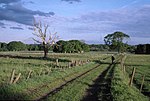Newcastle International Airport

Newcastle International Airport (IATA: NCL, ICAO: EGNT) is an international airport in Newcastle upon Tyne, England. Located approximately 7.7 mi (12.4 km) from Newcastle City Centre, it is the primary and busiest airport in North East England, and the second busiest in Northern England. In 2019, prior to the COVID-19 pandemic, Newcastle International handled 5.2 million passengers annually.Newcastle Airport has a Civil Aviation Authority Public Use Aerodrome Licence (Number P725) that allows flights for the public transport of passengers or for flying instruction. In 2019, it was named the best airport in Europe of those serving 5–15 million passengers annually by Airports Council International (ACI) for the second consecutive year.
Excerpt from the Wikipedia article Newcastle International Airport (License: CC BY-SA 3.0, Authors, Images).Newcastle International Airport
Airport Freightway, Newcastle upon Tyne Woolsington
Geographical coordinates (GPS) Address Nearby Places Show on map
Geographical coordinates (GPS)
| Latitude | Longitude |
|---|---|
| N 55.038055555556 ° | E -1.6897222222222 ° |
Address
Airport Freightway
NE13 8BZ Newcastle upon Tyne, Woolsington
England, United Kingdom
Open on Google Maps








